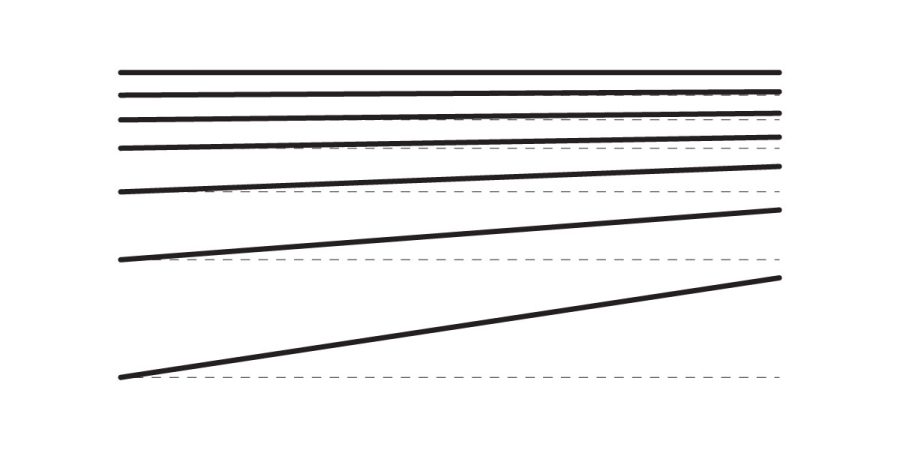Pitch
PITCH is the ratio of RISE to RUN. Pitch is also considered the slope RATIO.
- Rise is given first, and then run.
- Note this is different from (X, Y) coordinates, in which you give the “X” value before “Y”. For cartesian coordinates, you ‘run before you jump’.
- Both rise and run need to be in the same units. Typically the run is given in 12 (inches per foot).
- Even if the slope fraction can be reduced, it’s sometimes still given out of 12 as a reference point for the value.
- 5:12 = 5 inches rise to 12 inches run.
Slope can also be given in percentages. To calculate slope %, take the rise and divide by the run. Then multiply by 100%
- 5:15 = 5 divided by 15 = .3333 x 100% = 33.3% slope
- 5:10 = 5 divided by 10 = .5000 x 100% = 50.0% slope
Note: Finished surfaces should always have positive drainage and be free of undrained depressions since these may cause water stagnation. Using a minimum slope of 1.5% allows for deviations or construction tolerance that may result in the slope being less than designed.
Slope Chart
|
Used for and examples… |
% |
Inch per ft |
Ratio |
Written |
|
Unpaved slopes do not drain well; Slopes less than 1% should not be designed as there will inevitably be undrained depressions and water stagnation. |
<1% |
– |
– |
– |
|
Absolute minimum slope for roof drainage; more is preferred as 1% slope can be difficult to achieve with construction tolerances. |
1% |
~1/8 in/ft |
1:100 |
1 foot height change over 100 feet |
|
Minimum recommended slope for drainage; Minimum slope for parking areas (1.5 to 5.0) |
1.5% |
1.5:100 |
||
|
Minimum slope for drainage away from buildings (grade slope 2.0 to 50) Maximum permissible cross slope for ADA walkway/ramp Maximum slope for ADA parking space |
2% |
~1/4 in/ft |
1:50 |
1 foot height change over 50 feet |
|
Maximum desirable slope of a grassy (outdoor) area used for recreation (2% desirable) |
3% |
|||
|
Walks next to building should not exceed |
4% |
|||
|
Maximum slope for parking areas (1.5 to 5.0) |
5% |
1:20 |
1 foot height change over 20 feet |
|
|
Max slope for streets used by vehicles |
10% |
1:10 |
1 foot height change over 10 feet |
|
|
Max slope for automobile ramp where pedestrians are allowed |
12% |
1:8.33 |
||
|
Max slope a vehicle can climb for a sustained period of time without long term damage to the automobile. Max for automobile ramp when pedestrians are prohibited |
15% |
1:6.66 |
||
|
20% |
1:5 |
1 foot height change over 5 feet |
||
|
Max slope for grass to stabilize the soil. Anything more and it will be hard to mow. |
25% |
1:4 |
1 foot height change over 4 feet |
|
|
In order to help stabilize soil, plant ground cover that won’t need to be mowed. This slope only works if the soil is stable. |
25%-50% |
– |
||
|
For slopes over 50%; check dams or retaining walls should be introduced to control & reduce soil erosion. Avoid slopes of 50% or greater due to erosion from water runoff. Slopes of this grade are very steep and not suitable for any kind of non-specialized activity. (grade slope 2.0 to 50) |
50% |
1:2 |
1 foot height change over 2 feet |
|
|
This is a 45 degree slope |
100% |
1:1 |
1 foot height change over 1 foot |
Rules of Thumb
- 2-3% can be used for calculating the slope of parking lots.
- Quick calculations: across a 62’-0” double loaded parking aisle should have a grade change of 1’-0” minimum and max of 3’-0”
- Interchanges (roads)
- Up-Ramps to interchanges 3-6%
- Down Ramps from interchanges 8%
- 2.0 to 10% – Drainage ditches
- 0.5 to 1.5% – Sanitary sewers (depending on diameter)
- 2.0 to 3.0% – Grassy areas for recreation
- 1.5 to 5.0% – Paved parking areas
- 0.5 to 10.0% – Roads



Leave a Reply
You must be logged in to post a comment.